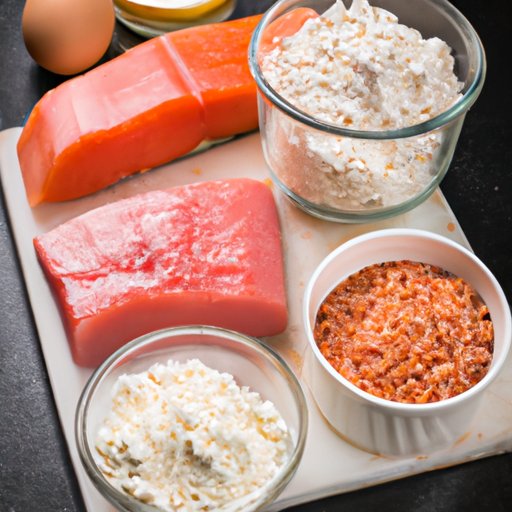
Introduction
Protein is an essential macronutrient that plays a crucial role in building and repairing muscle, bones, and skin. It also helps to regulate hormones and enzymes, keeping your body functioning properly. However, many people struggle to get enough protein in their diet, leading to deficiencies and health issues. In this article, we will explore tips and tricks to help you get more protein in your diet and feel your best.
Highlight Protein-Rich Foods
The most obvious way to increase protein in your diet is to incorporate protein-rich foods into your meals. Meat, fish, eggs, nuts, and beans are all excellent sources of protein. For example:
– Chicken breast: 3 oz contains about 26 grams of protein
– Salmon: 3 oz contains about 22 grams of protein
– Eggs: 1 large egg contains about 6 grams of protein
– Almonds: ¼ cup contains about 6 grams of protein
– Black beans: ½ cup contains about 8 grams of protein
Choosing protein-rich foods over processed or sugary snacks not only provides essential nutrients but also helps to keep you feeling full and satisfied.
Include Protein Supplements
Protein supplements offer a convenient way to increase protein intake, especially for those with busy lifestyles. Whey protein, casein protein, and plant-based protein are all popular options. Whey is a fast-digesting protein that is derived from cow’s milk and is an excellent choice for post-workout recovery. Casein protein, also derived from cow’s milk, is slower to digest and provides a steady supply of protein over several hours. Plant-based protein, such as pea, soy, or hemp protein, offers a vegan-friendly option for those who avoid animal products.
When choosing a protein supplement, it’s important to consider personal needs and preferences. Whey protein, for example, is not suitable for those with lactose intolerance or milk allergies. It’s also essential to consult a doctor or dietitian before adding supplements to your diet, especially if you have underlying health issues.
Incorporate Food Swaps
Swapping out processed or low-nutrient foods for high-protein alternatives is an easy way to increase protein intake without sacrificing taste. Replace white bread with whole wheat bread for a protein and fiber boost. Substitute rice or potatoes for quinoa or buckwheat to get more protein, vitamins, and minerals. Some high-protein snacks include Greek yogurt, cottage cheese with fruit, or a handful of nuts.
Offer Easy High-Protein Recipes
Cooking at home is an excellent way to ensure that you are getting enough protein in your diet. Here are some easy-to-make recipes that are high in protein:
– Protein smoothie: In a blender, combine 1 scoop of whey protein powder, 1 cup of almond milk, 1 banana, and ½ cup of frozen berries. Blend until smooth.
– Protein bars: Combine 2 cups of oats, ½ cup of chopped nuts, 1/3 cup of honey, and 2 scoops of protein powder. Mix well, then bake in a square pan at 350°F for 20-25 minutes. Cut into bars.
– Quiche: Beat 3 eggs and ¼ cup of milk together. Stir in ½ cup of shredded cheese, 1 cup of veggies, and 1 cup of cooked ham or sausage. Pour into a greased pie dish and bake at 350°F for 30-35 minutes.
Talk About Protein Requirements
Protein requirements vary depending on age, sex, weight, and activity level. In general, the recommended daily intake of protein is 0.8 grams per kilogram of body weight. However, athletes and active individuals may require more protein to support muscle growth and recovery. A registered dietitian or doctor can help determine your specific protein needs.
Consider Meal-Prepping
Meal-prepping is a great way to save time and ensure that you have a steady supply of protein throughout the week. Batch-cooking protein-rich meals like grilled chicken, beef stir-fry, or seasoned tofu can be portioned and stored in the fridge or freezer for quick and easy meals. Be sure to store food in airtight containers and reheat to a safe temperature to avoid foodborne illness.
Highlight Protein Combinations
Combining different foods can create a complete protein, which contains all nine essential amino acids. Combining rice with beans, for example, provides a complete protein source. Other protein combinations include peanut butter on whole wheat toast, hummus with veggies, or yogurt with granola.
Conclusion
Increasing protein intake does not have to be complicated or time-consuming. Incorporating protein-rich foods, protein supplements, food swaps, easy recipes, and meal-prepping are all great methods to get more protein into your diet. Don’t forget that protein requirements vary based on individual factors, and it’s always best to consult a professional before making any significant dietary changes. With a little planning and creativity, you can enjoy delicious and nutritious meals and feel your best.




